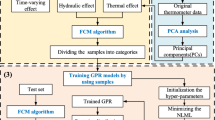Abstract
To identify the behavior and health monitoring of dams, it is necessary to correctly interpret the results of instrumentation in different phases of dam construction, impounding, and operation. Therefore, the approach based on spatiotemporal prediction is presented to improve the interpretation of pore pressure behavior of Eyvashan Dam. Using the results of other existing healthy piezometers, this research proposes a zoned pore pressure clustering two-stage distribution model using panel data that can reconstruct the missing data. In the first stage, the optimal spatiotemporal clustering of pore pressure change monitoring is obtained by designing a Fuzzy C-Means method (FCM), which will enable the monitoring of points of the dam where instrumentation has not been designed and installed. In the second step, the Group Method of Data Handling (GMDH) model has been used to predict pore pressure using points located in a cluster. The results of the statistical performance evaluation of the data show that the two-stage clustering model of FCM and GMDH algorithm, taking into account the time delay, can be a suitable and efficient method in modeling and predicting pore pressure. The proposed method will facilitate the detection of unusual areas of piezometric pressure and related safety diagnosis.













Similar content being viewed by others
References
Anastasakis L, Mort N (2001) The development of self-organization techniques in modelling: a review of the group method of data handling (GMDH). Department of Automatic Control and Systems Engineering. No. 813, The University of Sheffield, United Kingdom
Beiranvand B, Komasi M (2021a) An Investigation of performance of the cutoff wall and numerical analysis of seepage and pore pressure of Eyvashan earth dam. Iran J Sci Technol Trans Civ Eng 45(3):1723–1736. https://doi.org/10.1007/s40996-021-00613-y
Beiranvand B, Komasi M (2021b) Study of the arching ratio in earth dam by comparing the results of monitoring with numerical analysis (case study: Marvak dam). Iran J Sci Technol Trans Civ Eng 45(2):1183–1195. https://doi.org/10.1007/s40996-020-00519-1
Beiranvand B, Rajaee T (2022) Application of artificial intelligence-based single and hybrid models in predicting seepage and pore pressure of dams: a state-of-the-art review. Adv Eng Softw (Barking, London, England: 1992) 173(103268):103268. https://doi.org/10.1016/j.advengsoft.2022.103268
Beiranvand B, Rajaee T, Komasi M (2024) Spatiotemporal clustering of dam settlement monitoring using instrumentation data (case study: Eyvashan Earth Dam). Results Eng 22(102014):102014. https://doi.org/10.1016/j.rineng.2024.102014
Chen L, Gu C, Zheng S, Wang Y (2024) A method for identifying gross errors in dam monitoring data. Water 16(7):978. https://doi.org/10.3390/w16070978
de Granrut M, Simon A, Dias D (2019) Artificial neural networks for the interpretation of piezometric levels at the rock-concrete interface of arch dams. Eng Struct 178:616–634. https://doi.org/10.1016/j.engstruct.2018.10.033
FEMA (2001) The national dam safety program research needs workshop on embankment dam failure analysis, June 26–28, 2001, Oklahoma City, Oklahoma
International Committee on Large Dams (1995) Dam failure statistical analysis. International Commission on Large Dams, Bulletin No. 99, Paris, 73p
Ivakhnenko AG (1968) The group method of data handling; a rival of the method of stochastic approximation. Soviet Autom Control 13(3):43–55
Li Y, Min K, Zhang Y, Wen L (2021) Prediction of the failure point settlement in rockfill dams based on spatial-temporal data and multiple-monitoring-point models. Eng Struct 243(112658):112658. https://doi.org/10.1016/j.engstruct.2021.112658
Najafzadeh M (2020) Projection of seepage and piezometric pressure in earth dams using soft computational models. Amirkabir J Civ Eng 52(7):1783–1796. https://doi.org/10.22060/ceej.2019.15667.5990
Nourani V, Babakhani A (2013) Integration of artificial neural networks with radial basis function interpolation in earthfill dam seepage modeling. J Comput Civil Eng 27(2):183–195. https://doi.org/10.1061/(asce)cp.1943-5487.0000200
Parsaie A, Haghiabi AH, Latif SD, Tripathi RP (2021) Predictive modeling of piezometric head and seepage discharge in earth dam using soft computational models. Environ Sci Pollut Res Int 28(43):60842–60856. https://doi.org/10.1007/s11356-021-15029-4
Ranković V, Novaković A, Grujović N, Divac D, Milivojević N (2014) Predicting piezometric water level in dams via artificial neural networks. Neural Comput Appl 24(5):1115–1121. https://doi.org/10.1007/s00521-012-1334-2
Salajegheh R, Mahdavi-Meymand A, Zounemat-Kermani M (2018) Evaluating performance of meta-heuristic algorithms and decision tree models in simulating water level variations of dams’ piezometers. J Hydraul Struct 4(2):60–80. https://doi.org/10.22055/jhs.2018.27833.1092
Sharghi E, Nourani V, Behfar N (2018) Earthfill dam seepage analysis using ensemble artificial intelligence-based modeling. J Hydroinf 20(5):1071–1084. https://doi.org/10.2166/hydro.2018.151
Takase K (1967) Statistic study on failure, damage and deterioration of earth dams in Japan. In: 9th ICOLD congress, vol Q34. Istanbul, Turkey, pp R1:1–19
Tinoco J, de Granrut M, Dias D et al (2020) Piezometric level prediction based on data mining techniques. Neural Comput & Applic 32:4009–4024. https://doi.org/10.1007/s00521-019-04392-6
Webb GI (2003) Preliminary investigations into statistically valid exploratory rule discovery. In: Proceedings of the Australasian data mining workshop (AusDM03). University of Technology, Sydney, pp 1–9
Ziggah YY, Issaka Y, Laari PB (2022) Evaluation of different artificial intelligent methods for predicting dam piezometric water level. Model Earth Syst Environ 8(2):2715–2731. https://doi.org/10.1007/s40808-021-01263-9
Author information
Authors and Affiliations
Contributions
B.B, M.K: Conceptualization; Data curation; Formal analysis; Investigation; Methodology; Writing – review & editing. B.B, T.R: Resources; Software; Roles/Writing – original draft; T.R: Supervision.
Corresponding author
Ethics declarations
Competing interests
The authors declare no competing interests.
Rights and permissions
Springer Nature or its licensor (e.g. a society or other partner) holds exclusive rights to this article under a publishing agreement with the author(s) or other rightsholder(s); author self-archiving of the accepted manuscript version of this article is solely governed by the terms of such publishing agreement and applicable law.
About this article
Cite this article
Beiranvand, B., Rajaee, T. & Komasi, M. Development of a Two-Stage Method for Zoned Pore Pressure Clustering Using FCM and GMDH Models (Case Study: Eyvashan Earth Dam). Iran J Sci Technol Trans Civ Eng (2024). https://doi.org/10.1007/s40996-024-01436-3
Received:
Accepted:
Published:
DOI: https://doi.org/10.1007/s40996-024-01436-3




